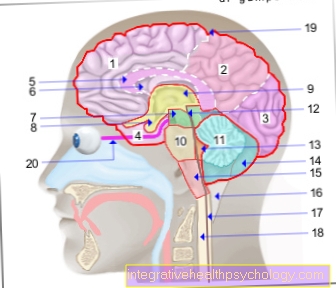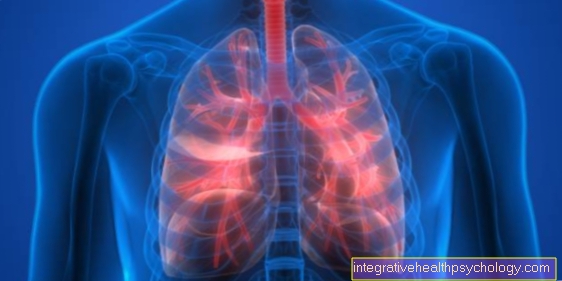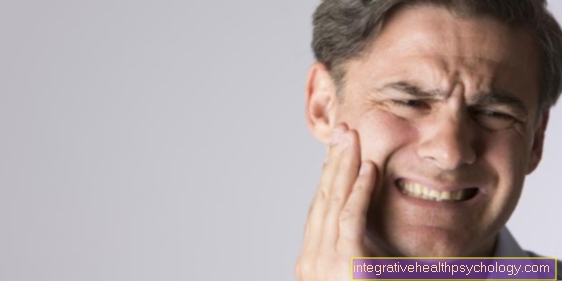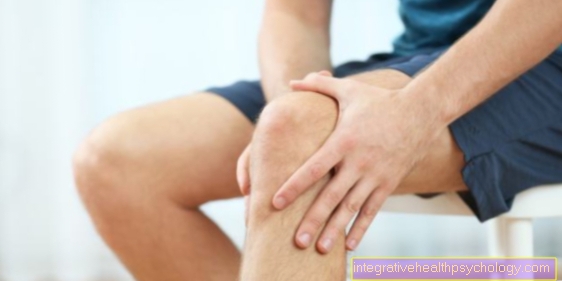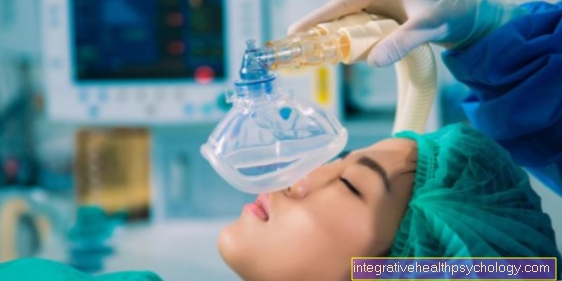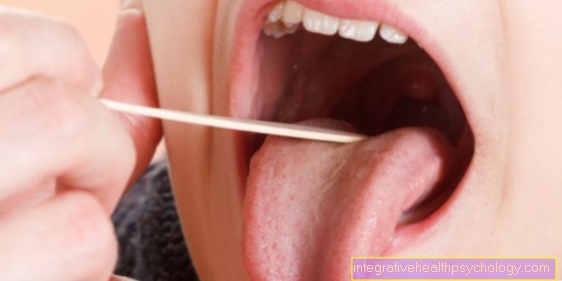Teething of the molar in the baby
definition
The eruption of teeth is a very difficult and exhausting time for both the little one and the parents. Often “teething” coincides with other infections, whereby the babies also suffer from fever or diarrhea. In one case earlier, in the other later, the first upper molars begin to protrude from the gums around the age of 12 months. The second molars appear later.

When does molar teething begin?
The baby's first molars appear around the age of one year.
Usually the first upper molar shows up between the ages of 12 and 18 months. A short time later, the first lower follows in the same period.
The second lower molar joins from around the 20th to 31st month of life.
The second upper molar tooth appears last, around the age of 2-2.5 years. All times are average values, the actual value can differ by several weeks or months.
How long does it take for the teeth to erupt?
The duration of tooth eruption depends on several factors and varies from child to child.
The teeth that erupt first, the incisors, sometimes only need a few days to be fully recognizable. The molars, on the other hand, can sometimes take several weeks or even months to fully erupt. This process is very individual and depends on genetics.
Even if you can alleviate the pain, there are unfortunately no aids that speed up teething. It usually takes up to 3.5 years for all teeth to erupt. If the teeth do not erupt at the usual time, this is not a cause for concern. Some babies just need a little more time. In the event of uncertainty, a (pediatric) dentist can be consulted at any time, who will be happy to help with all questions relating to tooth eruption.
Pain when teething the molar
Many, especially inexperienced, parents often misinterpret the signs of teething because babies do not all behave in the same way when teething. Some children show almost no symptoms, the first tooth in the morning shows its most beautiful white. Other children are in great pain and cannot sleep through the night. The characteristics of teething do not differ in molars compared to other teeth. They can be severe or less pronounced, occur individually or in combination. The most important symptoms are listed below:
-
Many babies suffer from swollen, red gums when they break their molars, which can sometimes become very inflamed. Especially when the little one puts a dirty hand in its mouth.
-
Red and hot cheeks are also not uncommon.
-
The hand or various objects are put in the mouth and attempts are made to chew on them.
-
A restless sleep with frequent fits of crying and crying can be observed.
-
Decrease in appetite despite good digestion.
-
Thin stools, even diarrhea, are often observed, which can cause the baby to develop a sore bottom. Constipation is less common.
-
Heavy drooling due to increased salivation.
Sometimes teething also coincides with other infections. Fever and diarrhea come with it. The reason for this is a weakened immune system. If the symptoms worsen or persist for a long time, a doctor's visit is urgently recommended.
How do I relieve the pain?
The pain caused by tooth eruption can be alleviated by the parents. It helps some babies if the reddened gums are massaged. Special silicone finger cots or your own finger can be used for this. Simply run it over the gums in circular movements.
A foot reflexology massage often has the desired effect and the tooth bar hurts less. Sore corners of the mouth and cheeks can occur due to the increased flow of saliva. These areas are less painful when you apply special baby care creams.
Distraction is also a good practice. The little ones then forget their suffering for a while. Walks, cradling in the arms or longer play units can provide the desired variety.
Home remedies for teething pain
There are many different methods that can be used to make the process more manageable. Most of them are based on the principle of gum massage. Some alternatives are presented below:
-
Cold washcloth: Some babies like to chew on soft objects because hard ones are perceived as uncomfortable. Simply soak a washcloth in cold water and wring it out. Then put it in the child's mouth, he knows what to do with it. Change several times a day due to hygiene.
-
Teether: An object that the child can put in their mouth and chew on. They are available in hard and soft, with and without water filling. A teething ring filled with water can be cooled in the refrigerator and thus also provides pain relief by swelling of the gums. It should never be put in the freezer. A frozen teether can stick to the skin and cause frostbite damage.
-
Hard foods: The older generation in particular is convinced that hard bread or carrots have a pain-relieving effect on teething. However, chewing should be closely monitored so that the little one does not choke or bite sore. If used too intensively, this method can promote the development of caries, as the food contains sugar.
Painkiller
If there are severe problems breaking through the molar, a pain reliever (such as paracetamol or ibuprofen in juice or suppository form) can be administered in consultation with a pediatrician.
Tooth gels such as Dynexan® oral gel, Kamistad® Baby Gel, Dentinox® Gel N Teething Aid or Osa® Herbal Tooth Gel can also alleviate pain when the molar tooth breaks through. To do this, the gel is applied to the painful area two to three times a day and massaged in.
Read more on the subject at: Tooth gel
Fever when teething
Fever or diarrhea are very often accompanying symptoms of tooth eruption. However, they are not triggered by the teething itself. The body of the little ones is very weak during this time and therefore more susceptible to infections. Viruses then have an easy job and can establish themselves in the body. This creates the fever.
The febrile baby should be given adequate food, drink, and bed rest. To do this, you should renew the (bed) linen several times a day.
Read more on the subject at: Diarrhea while teething
Fever-lowering measures should only be used from a body temperature of 39 ° Celsius. Here, compresses and compresses have proven themselves as home remedies. If you want to use stronger means, you can use paracetamol suppositories or fever-lowering drops and juices. However, this should only be done as directed by a doctor. It is important to know that only one symptom is combated, but not the cause itself. If the fever persists for a long time, a visit to the doctor cannot be averted!
Find out more about this topic: Fever when teething
Inflammation of the gums
When the molar erupts, the gums can swell, become red and often become inflamed. This is because bacteria migrate into the pocket between the erupting tooth and gum and cause inflammation there. The inflammation can be relieved by applying unsweetened chamomile tea or a chilled teether. If there is no improvement, it is advisable to see a doctor.
For more information, see Inflammation of the gums.
Bad breath when teething
While the baby is teething and the molar is erupting, the parents often notice an unpleasant bad breath in the baby. This is because the baby may experience pain when eating certain foods and change their eating habits. The composition of saliva changes and saliva production is stimulated. More saliva can absorb more bacteria and these produce breakdown and metabolic products that can cause the unpleasant odor. Regular brushing of erupting teeth is important for a healthy oral cavity.
Read more on the topic: Bad breath in the baby
Bruising while teething
Very often a bruise or bruise appears on the baby's gums where the new tooth breaks through. The reason for this is the small blood vessels that are injured when teeth break through.
The blood then leaks into the tissue and stains the gums blue. Sometimes it also coagulates and settles on the tooth. This is nothing to worry about as it is a normal process that occurs in most babies. As soon as the tooth passes through the gums a short time later, the bruise disappears on its own.
In some children, a blood-filled blue ball can be seen on the gums before a molar erupts. This is called a breakthrough cyst. A so far unexplained accumulation of fluid in the tooth sac is the reason. The check-up appointment at the dentist can be awaited. It is not a serious illness. Very often the cyst will go away without further action.
Read more on the subject at: Bruising on the baby
Black mouth during teething
When looking into the baby's mouth, the chewing surface of molars often appears very dark to black. Many parents immediately worry that this could be tooth decay. There is often only one simple reason behind it: the bruise just described. Usually these are not that easy to distinguish from one another, as the look into baby's mouth is only a very short one and everything appears dark there. You shouldn't panic and watch the affected molar. With regular brushing, the bruise should go away within a few days.
If this is not the case and the whole tooth really appears black, a visit to the (pediatric) dentist is necessary. A high-sugar diet of the child with juices and tea can be the cause of pronounced tooth decay. A dead tooth nerve, triggered by trauma, can also be the reason for the dark discoloration.

